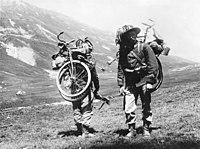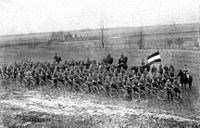Bicycle infantry

| Part of a series on |
| War |
|---|
 |
Bicycle infantry are
History
Origins

The development of
In 1887 the first of a series of cyclist maneuvers involving British volunteer units was held.

Late in the 19th century the United States Army tested the bicycle's suitability for cross-country troop transport. The most extensive experimentation on bicycle units was carried out by 1st Lieutenant James A. Moss, of the
The first known use of the bicycle in combat occurred during the 1895 Jameson Raid, in which cyclists carried messages. In the Second Boer War military cyclists were used primarily as scouts and messengers. One unit patrolled railroad lines on specially constructed tandem bicycles that were fixed to the rails. Several raids were conducted by cycle-mounted infantry on both sides; the most famous unit was the Theron se Verkenningskorps (Theron Reconnaissance Corps) or TVK, a Boer unit led by the scout Daniel Theron, whom British commander Lord Roberts described as "the hardest thorn in the flesh of the British advance." Roberts placed a reward of £1,000 on Theron's head—dead or alive—and dispatched 4,000 soldiers to find and eliminate the TVK.[8]

World Wars
During World War I cycle-mounted infantry, scouts, messengers and ambulance carriers were extensively used by all combatants. Italy used bicycles with the
Prior to the start of trench warfare the level terrain in Belgium was well used by military cyclists. Each of the four Belgian carabinier battalions included a company of cyclists, equipped with a brand of folding bicycle named the Belgica. A regimental cyclist school gave training in map reading, reconnaissance, reporting and the carrying of verbal messages. Attention was paid to the maintenance and repair of the machine itself.[9]
In its 1937
During the Invasion of Poland of 1939, most Polish infantry divisions included a company of bicycle-riding scouts. The equipment of each bicycle company included 196 bicycles, one motorcycle with sidecar, and nine horse-drawn supply carts, plus three to six anti-tank rifles and standard infantry equipment such as machine guns, rifles, pistols, and hand grenades.[10][circular reference]
The Finnish Army utilized bicycles extensively during the Continuation War and Lapland War. Bicycles were used as a means of transportation in Jaeger Battalions, divisional Light Detachments and regimental organic Jaeger Companies. Bicycle units spearheaded the advances of 1941 against the Soviet Union. Especially successful was the 1st Jaeger Brigade which was reinforced with a tank battalion and an anti-tank battalion, providing rapid movement through limited road network. During winter time these units, like the rest of the infantry, switched to skis. Within 1942–1944 bicycles were also added to regimental equipment pools. During the Summer 1944 battles against the Soviet Union, bicycles provided quick mobility for reserves and counter-attacks. In Autumn 1944 bicycle troops of the Jaeger Brigade spearheaded the Finnish advance through Lapland against the Germans; tanks had to be left behind due to the German destruction of the Finnish road network.
The hastily assembled German Volksgrenadier divisions each had a battalion of bicycle infantry, to provide a mobile reserve.
Allied use of the bicycle in World War II was limited, but included supplying folding bicycles to paratroopers and to messengers behind friendly lines. The term "bomber bikes" came into use during this period, as US forces dropped bicycles out of planes to reach troops behind enemy lines.
By 1939, the
-
Italian Bersaglieri before World War I with folding bicycles strapped to their backs
-
German bicycle infantry during World War I
-
Most common bicycle used by Polish scout companies assigned to infantry divisions during theGerman invasion of Poland
-
Danish soldiers cycling to the front to fight the Germans during the German invasion of Denmark in 1940
-
Wehrmacht troops advancing on bicycles in 1944
Later uses
Although much used in World War I, bicycles were largely superseded by motorized transport in more modern armies. In the past few decades, however, they have taken on a new life as a "weapon of the people" in
21st century
The use of the cycle as an infantry transport tool continued into the 21st century with the Swiss Army's Bicycle Regiment, which maintained drills for infantry movement and attack until 2001, when the decision was made to phase the unit out.[11]
Although the impact of bicycles is limited in modern warfare, the Finnish Defence Forces still trains all conscripts to use bicycles and skis.[12] American Paratroopers have jumped folding mountain bikes in several Airborne operations [13]
The Liberation Tigers of Tamil Eelam made use of bicycle mobility during the Sri Lankan Civil War.[citation needed]
During the Russian invasion of Ukraine, electric bicycles were used for anti tank purposes. [14]
See also
- April 9th (film)—a 2015 Danish film about a group of Danish bicycle infantry during the German invasion of Denmark (1940).
- Army Cyclist Corps
- Australian Cycling Corps
- Reich Labour Service
- Swiss army bicycle
Citations
- ^ Leiser 1991, p. 10.
- ^ Leiser 1991, pp. 11–16.
- ^ R. Wilson, page 32, "East York Volunteer Infantry 1859-1908", Fineprint Hull 1982
- ^ Chisholm, Hugh, ed. (1911). . Encyclopædia Britannica. Vol. 07 (11th ed.). Cambridge University Press. pp. 682–685, see page 685, final para.
Military....The cycle has also been taken up for military purposes. For this idea the British army is indebted to Colonel A. R. Savile, who in 1887 organized the first series of cycle manœvres in England. Since then military cycling has undergone a great development, not only in the country of its origin but in most others.
- ^ An article written by Sir Arthur Conan Doyle, published in the Daily Express of 8 February 1910, argued the case for Yeomanry cyclists replacing mounted troops. Prime arguments given were numbers available, tactical advantage, rapidity, and relative cheapness
- ^ Leiser 1991, p. 11.
- ^ The Bicycling Buffalo Soldiers
- ^ "Danie Theron". Archived from the original on 8 February 2009. Retrieved 7 October 2007.
- ISBN 978-1-78331-094-4
- ^ pl:Kompania kolarzy w 1939
- ^ Doole, Claire (11 May 2001). "End of road for Swiss army cyclists". BBC News. Retrieved 5 February 2008.
- ^ "Puolustusvoimien polkupyörillä ei enää ole merkitystä sodan aikana". 15 April 2009.
- ^ "1st Tactical Studies Group (Airborne), Operation: Dark Claw". combatreform.org. 22 April 2011. Retrieved 28 June 2023.
- ^ Parker, Connor (19 May 2022). "Ukrainians using e-bikes mounted with missiles to blow up Russian tanks". Yahoo! News. Retrieved 20 May 2022.
General and cited references
- Leiser, Rolf (1991). Hundert Jahre Radfahrer-Truppe, 1891–1991 [Bicycle Troops, 1891–1991] (in German). Bern, Switzerland: Bundesamt für Mechanisierte u. Leichte Truppen. OCLC 885590986.
- Fitzpatrick, Jim (1998). The Bicycle in Wartime: An Illustrated History. Washington, D.C.: Brassey's Inc. ISBN 1-57488-157-4.
- Ekström, Gert; Husberg, Ola (2001). Älskade cykel (1st ed.). Bokförlaget Prisma. ISBN 91-518-3906-7.
- Koelle, Alexandra V. (2010). "Pedaling on the Periphery: The African American Twenty-fifth Infantry Bicycle Corps and the Roads of the American Expansion". The Western Historical Quarterly. 41 (3): 305–26. .
- Fletcher, Marvin E. (Autumn 1974). "The Black Bicycle Corps". Arizona and the West. 16 (3): 219–32. JSTOR 40168452.
External links
 Media related to Bicycle troops at Wikimedia Commons
Media related to Bicycle troops at Wikimedia Commons





